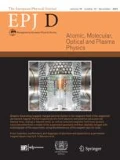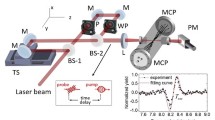Abstract.
We review how moderately intense laser fields offer an approach to alignment of molecules [1]. In particular, molecules can be aligned along a given space fixed axis, forced to a plane, or their rotations about all three possible axes can be eliminated by choosing a linearly polarized, a circularly polarized, or an elliptically polarized alignment field, respectively. We show how molecules in the gas phase can be aligned by turning on the laser field either slowly (a few nanoseconds) or fast (a few picoseconds) with respect to the rotational period of the molecules. The role of the intensity of the laser field and the rotational temperature of the molecules is discussed. Before concluding we describe how aligned molecules enables control and selectivity in the interaction between polarized light and molecules.
Similar content being viewed by others
References
This paper is a summary of an invited lecture presented at the 9th International Conference On Multiphoton Processes at Elounda, Crete, October 18-23 (2002)
B. Friedrich, D. Herschbach, Phys. Chem. Chem. Phys. 2, 419 (2000)
P. Bernath, Spectra of Atoms and Molecules (Oxford University Press, New York, 1995)
B.A. Zon, B.G. Katsnel’son, Sov. Phys.-JETP 42, 595 (1976)
T. Seideman, J. Chem. Phys. 103, 7887 (1995)
B. Friedrich, D.R. Herschbach, Phys. Rev. Lett. 74, 4623 (1995)
Due to space limitation the theory of molecular alignment is not discussed here. We refer the interested reader to references [5,6,14-18]
W. Kim, P.M. Felker, J. Chem. Phys. 104, 1147 (1996)
H. Sakai , J. Chem. Phys. 110, 10235 (1998)
J.J. Larsen, H. Sakai, C.P. Safvan, I. Wendt-Larsen, H. Stapelfeldt, J. Chem. Phys. 111, 7774 (1999)
W. Kim, P.M. Felker, J. Chem. Phys. 107, 2193 (1997)
J.J. Larsen, K. Hald, N. Bjerre, H. Stapelfeldt, T. Seideman, Phys. Rev. Lett. 85, 2470 (2000)
Several groups have reported calculations on nonadiabatic alignment some of them are references [14-18]
J. Ortigoso, M. Rodriguez, M. Gupta, B. Friedrich, J. Chem. Phys. 110, 3870 (1999)
T. Seideman, Phys. Rev. Lett. 83, 4971 (1999)
C.M. Dion, A. Keller, O. Atabek, A.D. Bandrauk, Phys. Rev. A 59, 1382 (1999)
M. Machholm, J. Chem. Phys. 115, 10724 (2001)
N.E. Henriksen, Chem. Phys. Lett. 312, 196 (1999)
F. Rosca-Pruna, M.J.J. Vrakking, J. Chem. Phys. 116, 6567 (2002)
E. Peronne, M.D. Poulsen, C.Z. Bisgaard, H. Stapelfeldt, T. Seideman, Phys. Rev. Lett. (submitted)
J.J. Larsen, I. Wendt-Larsen, H. Stapelfeldt, Phys. Rev. Lett. 83, 1123 (1999)
M.D. Poulsen, E. Skovsen, H. Stapelfeldt, J. Chem. Phys. 117, 2097 (2002)
T. Seideman, M.Yu. Ivanov, P.B. Corkum, Phys. Rev. Lett. 75, 2819 (1995)
T. Seideman, M.Yu. Ivanov, P.B. Corkum, Chem. Phys. Lett. 252, 181 (1996)
J.H. Posthumus, A.J. Giles, M.R. Thompson, K. Codling, J. Phys. B 28, L349 (1995)
T. Zuo, A.D. Bandrauk, Phys. Rev. A 52, 2511 (1995)
The radial distribution is obtained by an angular integration of the 2-dimensional I\(^{2+}\) ion image. It is proportional to the projection of the ion velocity on the detector, which in term, is very close to the full ion velocity because the alignment of the molecules causes the ions to be ejected in the plane of the detector
ICl was seeded in 1 bar of helium and \(I_{\rm YAG} = 6 \times 10^{11}\) W/cm\(^2\)
C.M. Dion , Phys. Rev. A 65, 063408 (2002)
K. Hoki, Y. Fujimura, Chem. Phys. 267, 187 (2002)
V.R. Bhardwaj, D.M. Rayner, D.M. Villeneuve, P.B. Corkum, Phys. Rev. Lett. 87, 253003 (2001)
R. Velotta, N. Hay, M.B. Mason, M. Castillejo, J.P. Marangos, Phys. Rev. Lett. 87, 183901 (2001)
T. Seideman, Annu. Rev. Phys. Chem. 53, 41 (2002)
R.A. Bartels , Phys. Rev. Lett. 88, 013903 (2002)
V. Kalosha, M. Spanner, J. Herrmann, M. Ivanov, Phys. Rev. Lett. 88, 103901 (2002)
Author information
Authors and Affiliations
Corresponding author
Additional information
Received: 15 November 2002, Published online: 18 March 2003
PACS:
33.15.Bh General molecular conformation and symmetry; stereochemistry - 32.80.Lg Mechanical effects of light on atoms, molecules, and ions - 33.80.Gj Diffuse spectra; predissociation, photodissociation - 33.80.Rv Multiphoton ionization and excitation to highly excited states (e.g. Rydberg states) - 34.50.Lf Chemical reactions, energy disposal, and angular distribution, as studied by atomic and molecular beams
Rights and permissions
About this article
Cite this article
Stapelfeldt, H. Alignment of molecules by strong laser pulses. Eur. Phys. J. D 26, 15–19 (2003). https://doi.org/10.1140/epjd/e2003-00064-2
Issue Date:
DOI: https://doi.org/10.1140/epjd/e2003-00064-2




